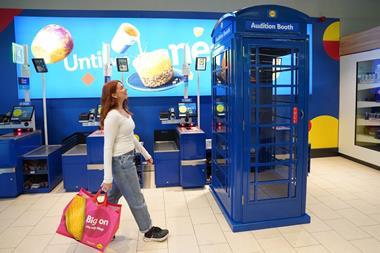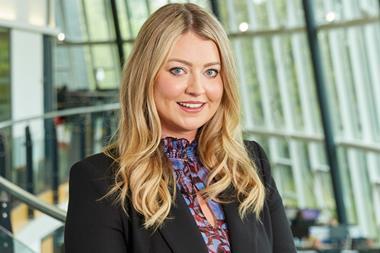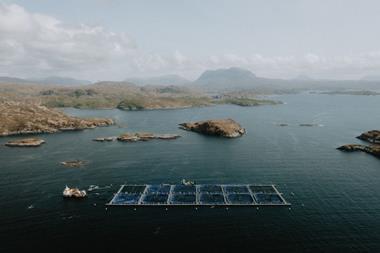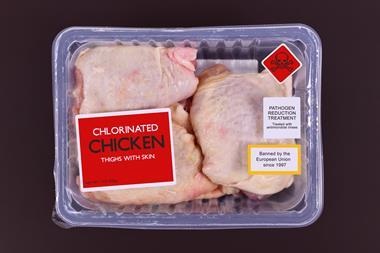Morrisons is finally tightening its grip on Safeway. Now it will move fast to get things running its way. What can suppliers expect? Elaine Watson reports
With almost a year now elapsed since Morrisons stunned the trade with a bid for Safeway, those likely to be directly affected have had more than enough time to formulate their response.
Which is just as well, as suppliers can expect a call from Morrisons’ trading team sooner rather than later if its latest offer gets the thumbs up from shareholders next year, says joint MD Bob Stott. “We will need to move more quickly than previously anticipated given Safeway’s performance versus a year ago.”
It will also move more aggressively, with £75m a year, rather than the original estimate of £50m, to be invested in price to bring Safeway into line with Morrisons.
Safeway’s promotional flyers will be phased out as quickly as possible, saving £75m, while the buying team will be the first casualties at head office, says Stott - all before Morrisons even hoists its name over the first Safeway store in the summer.
The speed with which Morrisons will be able to save a proposed £70m through combining the buying books of the two companies is a moot point, however, as several Safeway own label suppliers have recently negotiated lengthy fixed-term contracts with the chain on the understanding that its new owner would honour them. Some of these run up to October 2004, and came at a heavy price.
However, most suppliers we contacted were prepared for some tough negotiations, whether they had fixed-term contracts with Safeway or not.
One small supplier said: “My gut feeling is that Morrisons will tackle the top five suppliers across each category first. Profitability-wise it’s going to be painful for us, but there are clearly plus points.
“Safeway has become a pretty dreadful company to do business with. The deals are very complicated and everything comes with a price tag attached. Morrisons is tough but straightforward. However, they will have to invest a lot in margin straight away, while the volume benefits will take at least 12-18 months to come through.”
The first casualties in bringing procurement under one umbrella will be own label suppliers and tertiary brands, predicts one source close to Safeway. “They will look at each category and keep the main brand, the second brand, and an own label. After that, you are on shaky ground.” The fixed term contracts Safeway may have negotiated recently may be binding, he adds, “but if Morrisons comes to you and says, ‘I want to build a relationship with you,’ what do you do? If suppliers have been stupid enough to put big sums on the table in the last few months, that’s their lookout.”
Long-term, meat and produce suppliers to Safeway potentially have the most to lose, as Morrisons buys, packs and distributes these products in-house.
Until it builds new abattoirs, packhouses and another fresh food factory, however, Morrisons will not be able to cope with Safeway volumes in-house, and suppliers should be safe in the short term, predicts meat supplier ANM Group.
Chief executive Brian Pack says: “They won’t be able to move everything in-house straightaway, and even over time they will probably want to outsource some of this production. I wouldn’t panic immediately.”
The general consensus is that new buying terms may be negotiated very quickly, with Morrisons attempting to iron out discrepancies and go for the quick wins, but the broader supplier rationalisation process that may follow would take far longer.
Conversely, there will be lots of opportunities for enterprising Safeway suppliers to benefit from the deal, with those making its The Best premium own label range particularly well positioned as Morrisons has no equivalent, says Stott.
Next on Sir Ken’s to do list, is the mammoth task of integrating 427 Safeway stores and five RDCs and expanding its own fresh food and meat packing facilities to cope with the extra volume - all in in just two and a half years. Given Morrisons has no experience of trading from smaller stores, and Safeway has 138 of them below 15,000 sq ft, these could present the biggest challenge, suggest observers.
The plan is to put Morrisons’ own label products in these smaller stores, yet keep the Safeway name above the front door - a strategy that could confuse customers, warns former Somerfield chief executive David Simons. “There is always the danger of confusing people. Selling off these stores at some point would be a good strategy. The only question is whether the competition authorities would allow it.”
The fact that Morrisons has not come up with a distinct sub-brand or new format for Safeway’s 138 smaller stores is proof enough that it doesn’t have a long-term strategy for them, claims another retail source: “My guess is that Sir Ken will want to shed the smaller town centre stores as quickly as possible.
“However, there are some smaller stores in rural areas that are probably quite profitable and he may want to keep those.”
Indeed Morrisons, which has very modest ambitions for the smaller stores in terms of driving sales densities, says there is “no shortage of buyers” and does not rule out the possibility of a sell-off if it can’t make them work.
As to the 52 stores Morrisons must divest, despite the restrictions placed on the big three chains as to which stores they can bid for, Morrisons is confident they will sell quickly, with the proceeds covering the £636m cash element to its new offer.
Waitrose is probably in pole position after the big three, while Marks and Spencer is barred from bidding as it is not classed as a one-stop-shop grocery provider.
The Grocer Top 50 chain Booths has also signalled its interest in four stores.
Asda, meanwhile, was putting a brave face on it when we spoke to chief executive Tony DeNunzio. “We are disappointed, clearly. We felt there were millions of shoppers who would have liked an Asda close to them. For us, Safeway was very much a nice-to-have, not a must-have.”
Opinions are divided over what will pose the biggest problem for Sir Ken in integrating two such disparate businesses, although most put systems integration near the top of the list. One source close to the company says: “Morrisons has an extremely experienced logistics director in Lawrence Christensen to help them. However, there is potential for disaster if systems don’t work.
“As for cultural differences, despite what the consultants say, that’s mostly a store issue. I don’t think this will mean huge problems.”
Few doubt the enormity of the task ahead, and this week’s revelation that Safeway’s trading area is actually 10% smaller than Morrisons originally thought due to discrepancies in the way the two chains do their sums only adds to the pressure.
However, most people are prepared to give the canny septuagenarian at Morrisons’ helm the benefit of the doubt. As 72-year-old Sir Ken reminded reporters at a press conference on Monday, Morrisons is more than capable of multi-tasking.
While its top brass were busy putting together one of the most audacious bids of the decade, he observed, Morrisons still managed to post the most impressive trading figures in the industry. With like-for-like sales for the first 17 weeks of the second half approaching double digits, his confidence looks pretty well founded.
With almost a year now elapsed since Morrisons stunned the trade with a bid for Safeway, those likely to be directly affected have had more than enough time to formulate their response.
Which is just as well, as suppliers can expect a call from Morrisons’ trading team sooner rather than later if its latest offer gets the thumbs up from shareholders next year, says joint MD Bob Stott. “We will need to move more quickly than previously anticipated given Safeway’s performance versus a year ago.”
It will also move more aggressively, with £75m a year, rather than the original estimate of £50m, to be invested in price to bring Safeway into line with Morrisons.
Safeway’s promotional flyers will be phased out as quickly as possible, saving £75m, while the buying team will be the first casualties at head office, says Stott - all before Morrisons even hoists its name over the first Safeway store in the summer.
The speed with which Morrisons will be able to save a proposed £70m through combining the buying books of the two companies is a moot point, however, as several Safeway own label suppliers have recently negotiated lengthy fixed-term contracts with the chain on the understanding that its new owner would honour them. Some of these run up to October 2004, and came at a heavy price.
However, most suppliers we contacted were prepared for some tough negotiations, whether they had fixed-term contracts with Safeway or not.
One small supplier said: “My gut feeling is that Morrisons will tackle the top five suppliers across each category first. Profitability-wise it’s going to be painful for us, but there are clearly plus points.
“Safeway has become a pretty dreadful company to do business with. The deals are very complicated and everything comes with a price tag attached. Morrisons is tough but straightforward. However, they will have to invest a lot in margin straight away, while the volume benefits will take at least 12-18 months to come through.”
The first casualties in bringing procurement under one umbrella will be own label suppliers and tertiary brands, predicts one source close to Safeway. “They will look at each category and keep the main brand, the second brand, and an own label. After that, you are on shaky ground.” The fixed term contracts Safeway may have negotiated recently may be binding, he adds, “but if Morrisons comes to you and says, ‘I want to build a relationship with you,’ what do you do? If suppliers have been stupid enough to put big sums on the table in the last few months, that’s their lookout.”
Long-term, meat and produce suppliers to Safeway potentially have the most to lose, as Morrisons buys, packs and distributes these products in-house.
Until it builds new abattoirs, packhouses and another fresh food factory, however, Morrisons will not be able to cope with Safeway volumes in-house, and suppliers should be safe in the short term, predicts meat supplier ANM Group.
Chief executive Brian Pack says: “They won’t be able to move everything in-house straightaway, and even over time they will probably want to outsource some of this production. I wouldn’t panic immediately.”
The general consensus is that new buying terms may be negotiated very quickly, with Morrisons attempting to iron out discrepancies and go for the quick wins, but the broader supplier rationalisation process that may follow would take far longer.
Conversely, there will be lots of opportunities for enterprising Safeway suppliers to benefit from the deal, with those making its The Best premium own label range particularly well positioned as Morrisons has no equivalent, says Stott.
Next on Sir Ken’s to do list, is the mammoth task of integrating 427 Safeway stores and five RDCs and expanding its own fresh food and meat packing facilities to cope with the extra volume - all in in just two and a half years. Given Morrisons has no experience of trading from smaller stores, and Safeway has 138 of them below 15,000 sq ft, these could present the biggest challenge, suggest observers.
The plan is to put Morrisons’ own label products in these smaller stores, yet keep the Safeway name above the front door - a strategy that could confuse customers, warns former Somerfield chief executive David Simons. “There is always the danger of confusing people. Selling off these stores at some point would be a good strategy. The only question is whether the competition authorities would allow it.”
The fact that Morrisons has not come up with a distinct sub-brand or new format for Safeway’s 138 smaller stores is proof enough that it doesn’t have a long-term strategy for them, claims another retail source: “My guess is that Sir Ken will want to shed the smaller town centre stores as quickly as possible.
“However, there are some smaller stores in rural areas that are probably quite profitable and he may want to keep those.”
Indeed Morrisons, which has very modest ambitions for the smaller stores in terms of driving sales densities, says there is “no shortage of buyers” and does not rule out the possibility of a sell-off if it can’t make them work.
As to the 52 stores Morrisons must divest, despite the restrictions placed on the big three chains as to which stores they can bid for, Morrisons is confident they will sell quickly, with the proceeds covering the £636m cash element to its new offer.
Waitrose is probably in pole position after the big three, while Marks and Spencer is barred from bidding as it is not classed as a one-stop-shop grocery provider.
The Grocer Top 50 chain Booths has also signalled its interest in four stores.
Asda, meanwhile, was putting a brave face on it when we spoke to chief executive Tony DeNunzio. “We are disappointed, clearly. We felt there were millions of shoppers who would have liked an Asda close to them. For us, Safeway was very much a nice-to-have, not a must-have.”
Opinions are divided over what will pose the biggest problem for Sir Ken in integrating two such disparate businesses, although most put systems integration near the top of the list. One source close to the company says: “Morrisons has an extremely experienced logistics director in Lawrence Christensen to help them. However, there is potential for disaster if systems don’t work.
“As for cultural differences, despite what the consultants say, that’s mostly a store issue. I don’t think this will mean huge problems.”
Few doubt the enormity of the task ahead, and this week’s revelation that Safeway’s trading area is actually 10% smaller than Morrisons originally thought due to discrepancies in the way the two chains do their sums only adds to the pressure.
However, most people are prepared to give the canny septuagenarian at Morrisons’ helm the benefit of the doubt. As 72-year-old Sir Ken reminded reporters at a press conference on Monday, Morrisons is more than capable of multi-tasking.
While its top brass were busy putting together one of the most audacious bids of the decade, he observed, Morrisons still managed to post the most impressive trading figures in the industry. With like-for-like sales for the first 17 weeks of the second half approaching double digits, his confidence looks pretty well founded.


















No comments yet